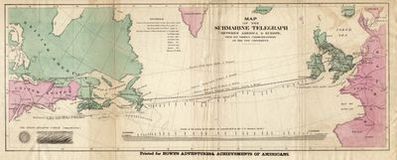Connecting the Continents

A transatlantic telegraph cable is an undersea cable running under the Atlantic Ocean used for telegraph communications.
After the first successful demonstration, telegraph lines were rapidly built all over Europe and North America, allowing messages to be sent virtually instantaneously. Crossing the water presented greater problems. The cable needed to be insulated and strong, technologies that were both in their infancy. The first major undersea link, connecting England to France, was not completed until 1851 after several failed attempts.
The First Transatlantic Cable
The manufacture of the first transatlantic cable was completed in June, 1857. Before the end of July it was stowed on the American Niagara and the British Agamemnon -- both naval vessels lent by their respective governments for the task. They started at Valentia Harbor in Ireland (which was by then connected to the rest of the British Isles) on August 5th. For the first few days, everything went well but six days later, due to a mistake made with the brake limiting the rate of descent, the cable snapped. Just 380 miles had been laid. Three more attempts were made to lay the cable starting at the mid point in the ocean but each time the cable broke. On July 29, 1858 they began their fifth attempt, again starting from the mid point. This time it worked! Both ships reached their destinations -- Valentia Harbor in Ireland and Trinity Bay in Newfoundland.
The Second Cable
In 1865 it was decided to lay a second cable. This time a single ship was chartered, the enormous Great Eastern, by far the largest ship of its day. She started from Valencia at the end of July 1865 and succeeded in laying 1,200 miles before the cable snapped. Several attempts were made to retrieve the broken end but they all failed. The Great Eastern was again loaded with enough cable for another attempt plus enough cable to connect the previous one if the end could be found.
On 27 July 1866, the new cable was pulled ashore at a tiny fishing village in Newfoundland known by the charming name of Heart’s Content. The distance was 1686 nautical miles.
Almost immediately the Great Eastern steamed east to the point that the second cable had reached and after about two weeks of trying, they found and raised the broken end. This was a difficult task, as the broken cable was at a depth of 16,000 feet. The broken end was spliced and on September 8, 1866 that cable was landed.
Almost immediately, the cables opened for business but only the very wealthy could afford it -- the initial rates were a startling $1 a letter, payable in gold.
These early pioneers were courageous and stalwart in completing the task at hand. Their dedication to the new technology of "telegraph" made it possible for people to "learn of the world" in ways never before dreamed of.
After the first successful demonstration, telegraph lines were rapidly built all over Europe and North America, allowing messages to be sent virtually instantaneously. Crossing the water presented greater problems. The cable needed to be insulated and strong, technologies that were both in their infancy. The first major undersea link, connecting England to France, was not completed until 1851 after several failed attempts.
The First Transatlantic Cable
The manufacture of the first transatlantic cable was completed in June, 1857. Before the end of July it was stowed on the American Niagara and the British Agamemnon -- both naval vessels lent by their respective governments for the task. They started at Valentia Harbor in Ireland (which was by then connected to the rest of the British Isles) on August 5th. For the first few days, everything went well but six days later, due to a mistake made with the brake limiting the rate of descent, the cable snapped. Just 380 miles had been laid. Three more attempts were made to lay the cable starting at the mid point in the ocean but each time the cable broke. On July 29, 1858 they began their fifth attempt, again starting from the mid point. This time it worked! Both ships reached their destinations -- Valentia Harbor in Ireland and Trinity Bay in Newfoundland.
The Second Cable
In 1865 it was decided to lay a second cable. This time a single ship was chartered, the enormous Great Eastern, by far the largest ship of its day. She started from Valencia at the end of July 1865 and succeeded in laying 1,200 miles before the cable snapped. Several attempts were made to retrieve the broken end but they all failed. The Great Eastern was again loaded with enough cable for another attempt plus enough cable to connect the previous one if the end could be found.
On 27 July 1866, the new cable was pulled ashore at a tiny fishing village in Newfoundland known by the charming name of Heart’s Content. The distance was 1686 nautical miles.
Almost immediately the Great Eastern steamed east to the point that the second cable had reached and after about two weeks of trying, they found and raised the broken end. This was a difficult task, as the broken cable was at a depth of 16,000 feet. The broken end was spliced and on September 8, 1866 that cable was landed.
Almost immediately, the cables opened for business but only the very wealthy could afford it -- the initial rates were a startling $1 a letter, payable in gold.
These early pioneers were courageous and stalwart in completing the task at hand. Their dedication to the new technology of "telegraph" made it possible for people to "learn of the world" in ways never before dreamed of.

